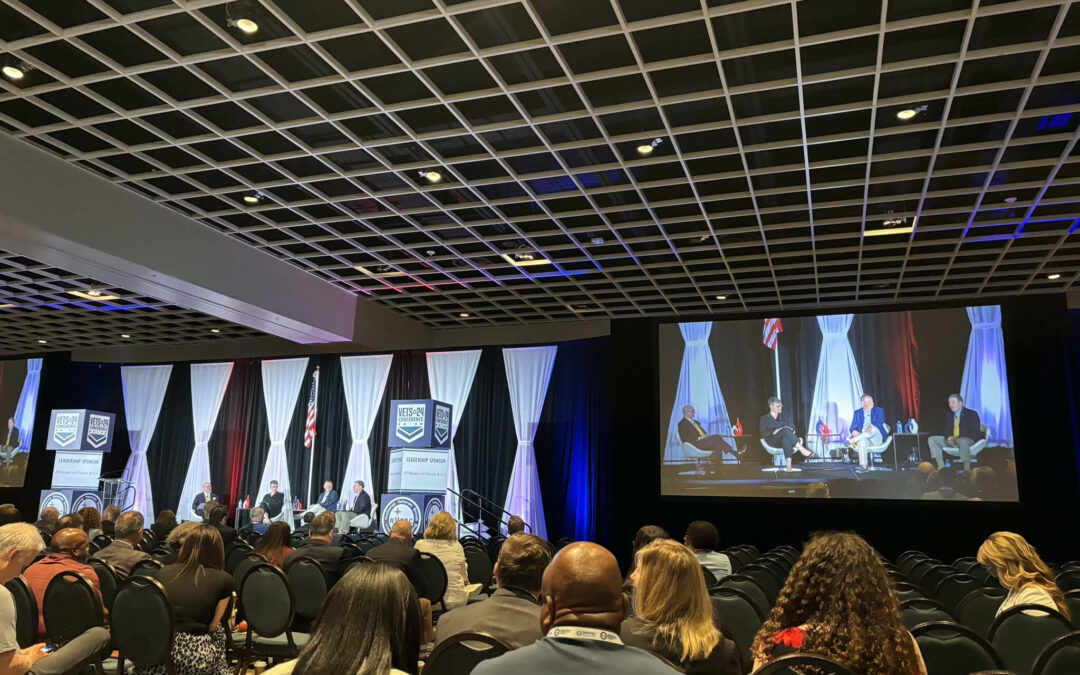Keeping up in the world of GovCon can take time and effort. With changing guidelines, regulations and technology, a lot of constant learning is involved, especially for small businesses. Parabilis recently attended VETS24, where we got to hear from business owners, experts and leaders of federal agencies. We also got to hear from those players about the top trends in federal procurement–and what business owners can do about it.
1. More Money, Fewer Contractors
One of the trends the GovCon space is seeing is the continued erosion of the small business industrial base. Essentially, there is more contract money being awarded, but fewer businesses are getting a slice of the pie.
Kevin Plexico, VP of Deltek GovWin, spoke at VETS24, and said the number of companies participating in the market is falling, and is likely down 20 to 30 percent in the last 5 years. He said to stay competitive in this space, companies can do a few things, like better market research on who is buying and what you’re selling. If you are just starting out, perhaps subcontracting is a better option and could get you a foot in the door while you’re still learning the space. Plexico also mentioned using compliance as a way to differentiate yourself. With the changes to CMMC and push for SAM compliance by the GAO, ensuring you are in line with rules and regulations is a good way to set yourself apart.
Federal agencies have also been working to determine if they have the right contract opportunities. Laura Stanton, Deputy Chief Acquisition Officer at the General Services Administration (GSA), says they have been trying to determine the markets where small businesses can be most competitive and encouraging subcontracting requirements that promote set-asides for small businesses within all of the socioeconomic certifications.
2. Utilization of Artificial Intelligence
It’s a common theme right now in everyday life: how do we use artificial intelligence and what does it mean for our future? This is no different in the GovCon world. As AI becomes more mainstream, there are questions about how businesses will use it to try to win and execute federal contracts, as well as how federal agencies will react to or regulate the use of it.
The Chief Acquisition Officer at the Department of Veterans Affairs, Mike Parrish, said data is at the center of everything that AI does, so if it’s fed bad data, you’ll get a bad result. Parrish believes we need to keep the ‘human in the loop,’ meaning we play a key role in the outputs we get from AI and we need to make sure we are checking those results, as well. Essentially, the opportunity with AI is powerful, but if you don’t know what you’re doing, it will end badly.
There’s also the question of whether businesses are able to use AI in proposal writing. Stanton said she didn’t know of a prohibition in the Federal Acquisition Regulation (FAR) that prohibited its use in proposal writing but cautioned against using it as a final draft. She said if a company is making claims about performance in a proposal, they better be able to meet them. Plexico agreed that AI could be a powerful tool in proposal writing, particularly for small businesses. However, it should only be a first draft. They also said it’s important to keep privacy and data in mind, as not all AI platforms are the most secure when you are dealing with sensitive information.
3. Category Management and Contract Vehicles
For years, there’s been concern about category management squeezing out small businesses. Small businesses argue that it consolidates purchasing into fewer, preferred suppliers, which restricts competition. The government, however, argues it allows agencies to meet small business contracting goals more effectively.
Stanton said category management gives the GSA a lens to look at strategic trends governmentwide. She said the agency can look at the data and begin to do breakdowns of submarkets that are good for small businesses. Stanton also said the government has a responsibility to get the best value for the American people. Plexico, however, agreed category management is making it hard for small businesses to enter the market. He said the opportunity is still there, but if you’re new to the market you will have to do a lot of subcontracting before becoming a prime.
Since category management isn’t going anywhere anytime soon, it’s worth taking a look at what small businesses can do if they are not currently on a contract vehicle. Parrish said those businesses may want to team up with others who are already on one by earning a place as a subcontractor and working their way up to a prime. Stanton says one of the easiest ways to enter the market is through the Multiple Award Schedule’s IT Category. She also said they are looking at ways to better incentivize subcontracting to small businesses.
Although the trend of fewer small businesses participating in the market is troubling, many resources are available to help. Groups like the National Veteran Small Business Coalition (NVSBC), Small Business Administration (SBA) and Women Impacting Public Policy (WIPP) are continuously working to connect federal agencies with minority and small business owners. They’re also lobbying in DC to advocate for set-asides for those groups. Stay tuned for upcoming information on this and many other topics impacting small and growing government contractors.
